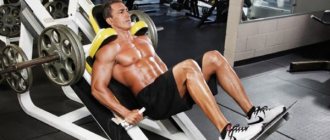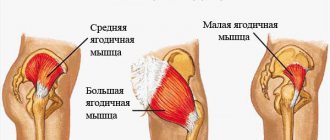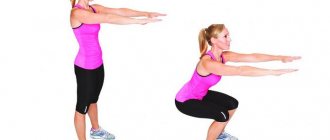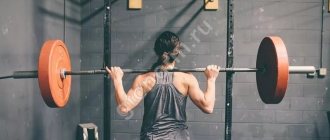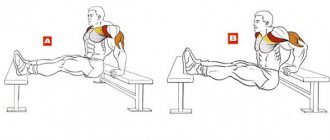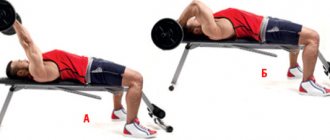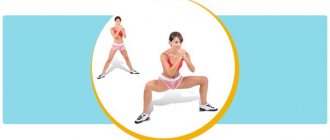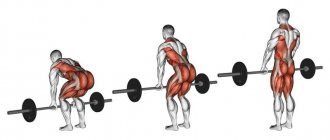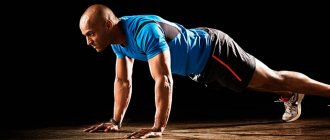Working weight exercise
Considering that this exercise is basic, it does not tolerate weak or lagging muscles. This means that if you want to increase the weight of the projectile, all the shortcomings of the technique can come out due to lagging links in the form of individual muscle groups. Therefore, the weight on the bar will be 25%, and maybe even 50% less than in classic squats. It depends on whether you performed a full descent to the bottom point or not. For example, if your weight was 100 kg in the classical form, and you squat below parallel, the barbell weight on the chest could be 85 kg. If not, it’s better to take 50 kg.
This huge difference is due to the fact that with regular squats the amplitude is partial. There is nothing terrible or shameful in this; work progress will not slow down. After all, better hip development will be achieved while minimizing injury. The barbell squat improves glute activation and allows for greater squat depth.
Did you know that...[edit | edit code]
A Danish study found that there is a relationship between leg size and heart health. Scientists studied about 3,000 men and women over 10 years, studying the development of heart disease and overall mortality. The risk of developing cardiovascular disease was approximately 2 times higher in those with a leg circumference of less than 56 cm (at the hip), and they also had a higher overall mortality rate during these years. Body fat had no effect on the relationship between larger leg volume and a reduction in these risks. Scientists have concluded that greater muscle mass may protect against the development of cardiovascular disease and reduce overall mortality.[27]
How should squats be performed?
- The movement begins with a smooth movement of the pelvis back - so that it looks like a person is trying to sit on an invisible potty.
The depth of squats can be up to the parallel of the hamstrings with the floor or lower. The lower the squat, the more the buttocks are involved in the work. The main thing is that when squatting below parallel, do not round your lower back and do not “crawl” with your knees beyond the line of your toes.
You need to sit down slowly and get up faster. You shouldn’t relax or pause at the bottom: there should be a quick, but at the same time smooth rise.
When rising from the bottom point, you do not need to straighten your legs all the way. Otherwise, the load is transferred to the knee joints.
The weight when rising from a squat should be through your heels, not through your toes. That is, in the squat position, the tension in the heels should be greater than in other areas of the foot.
Squats with weights are performed at a medium or slow pace. You need to take a deep breath, hold your breath and slowly lower yourself down. It is correct to start exhaling after overcoming the most difficult part of the climb.
You should always remove the barbell with extreme caution, because after performing a squat you are running out of strength. For stability, your legs can be spread out in a scissors position rather than held in one line.
Do not be intimidated by the large number of recommendations for the correct execution of a squat; they are all easy and with regular training will be brought to automaticity.
Sources[edit | edit code]
- Paul Dillet “Five Steps Up” (Russian) // Flex: magazine / chapter. ed. I. Lozinsky. - TORES LLC, 1998. - No. 1 (February, vol. 2). — P. 52-60.
- https://www.exrx.net/WeightExercises/GluteusMaximus/BBSquat.html
- “Biomechanics of the knee during closed kinetic chain and open kinetic chain exercises,” Medicine and Science in Sports and Exercise, vol. 30-4 (April), pp. 556—569, 1998
- "Complete Keys to Progress", John McCallum, ISBN 0-926888-01-3
- “Safety of the Squat Exercise,” Current Comment from the American College of Sports Medicine, pp. 1-3, March 2000
- https://www.pponline.co.uk/encyc/squats-how-safe-is-it-to-perform-a-squat-exercise-319?#
- “The effect of the squat exercise on knee stability,” Medicine and Science in Sports and Exercise, Volume 21 (3), pp. 299—303, 1989
- https://www.steelfactor.ru/doc/218
- Jimmy Pena (MN, USSR) “Wide stance squats vs. front squats.” (Russian) // “MuscleMag International” (English) Russian. : magazine / chap. ed. Johnny Fitness. - “MUSCLEMAG RUSSIA”, 2013. - No. 4(7). — P. 26.
- Squat safety - Training Tips - Cover Story - American Fitness Articles | Find Articles at CBS MoneyWatch.com
- https://www.myfit.ca/exercisedatabase/viewanexercise.asp?table=exercises&ID=136
- Kreighbaum, E., Katharine, B. M. (1996). Biomechanics; A Qualitative Approach for Studying Human Movement, Allyn & Bacon, 4, Pgs 203-204.
- Stuart McRobert, Insider's Tell-All Handbook on Weight-Training Technique. isbn:9963616097
- https://exrx.net/WeightExercises/Quadriceps/BBFrontSquat.html
- Jim Stoppani (D.S.) “Crunching in the knees and squats” (Russian) // Flex: magazine / chapter. ed. Igor Odnenko. - TORES LLC, 2011. - No. 1. - P. 27. - ISSN 1736-7190.
- https://biceps.com.ua/trening/mahni-ruchkoy-%C2%ABzhenskim-uprazhneniyami%C2%BB
- https://www.exrx.net/WeightExercises/Quadriceps/WTSissySquat.html
- https://www.verywell.com/best-butt-exercises-1230773
- https://www.fit4woman.ru/plies.html
- https://abcbodybuilding.com/exercise3/zerchersquat.htm
- https://cbass.com/Furey.htm
- https://fitn.ru/info/page_122_26.html
- https://www.verywell.com/squats-for-the-buns-hips-and-thighs-part-2-1231324#step3
- Exercise Library of Tutorials on Exercise Techniques and Equipment – Ways to Get Fit – American Council on Exercise
- https://www.powerliftingwatch.com/records/raw/world
- https://www.xn—-7sbjtacqslcmgoahmu2n2b.xn--p1ai/
- Jim Stoppani (D.S.) “Bigger legs, better heart” (Russian) // Flex: magazine / chapter. ed. Igor Odnenko. - TORES LLC, 2011. - No. 1. - P. 22. - ISSN 1736-7190.
Useful tips
The more weight is used, the more seriously the protection needs to be organized. A weightlifting belt can be used even during warm-up approaches; it will not affect the effectiveness of muscle pumping. For squats with weights close to your own and above, you need to use wrist wraps that protect your knees.
The abdominal muscles should also be kept slightly tense. This will prevent the body from swaying and make it easier to keep the body in a stable position.
Shoes for power squats should be chosen with hard soles and low heels. Sneakers filled with helium or air will have a negative impact on your equipment.
In cases where there are problems with joints, ligaments or back pain, you should not attempt squats without prior consultation and permission from a doctor.
How to squat correctly to avoid injury
Safety precautions when performing the exercise assume that during the entire training the athlete will not make sudden jerks. All parts of the exercise are performed smoothly, the load is increased gradually.
Correct technique will protect your knees, tendons and spine from injury.
So, it's important:
- During the entire execution period, do not lift your heels off the floor;
- Do squats exactly to the level when there is a feeling that your heels will begin to hang (approximately parallel to the floor);
- Help yourself with your abdominal muscles, keeping them tense starting from the moment you removed the barbell from the racks and returned it back;
- Maintain the natural arch in the spine, do not straighten your back excessively;
- Try to place your feet level and even slightly wider than your shoulders, and your toes can be turned to the sides;
- Be sure to hold the bar with a full palm with all fingers, otherwise it may slip out.
If an athlete has flat feet, then it is better to exercise in orthopedic insoles with optimal rigidity, otherwise the entire load will be directed into the knee joint, and this is fraught with the development of arthrosis after some time.
You should not round your back, otherwise injury in the lower back is likely due to excessive overload. It is better to perform the exercise with a straight back; for this purpose, visualization is used and a slight deflection in the lumbar spine is maintained.
About the benefits of the front squat
Squats with a barbell and dumbbells have a number of advantages over other exercises:
- a large group of muscles is involved and the hips develop well, the lower back and abs improve;
- reducing the load on the back, which prevents knee injury when squatting;
- the possibility of correctly performing the technique, otherwise the bar will begin to fall and an attempt will occur to hold the weight with your back, which will result in a correspondingly greater load on the back and possible fractures of the spinal vertebrae;
- development of stability of movements and formation of muscle performance;
- promoting better and faster fat burning and tightening of the involved muscles.
All of these advantages allow athletes to choose these exercises, and coaches to use these exercises when drawing up a training plan. Girls can also do the front squat, as it is an excellent option for losing weight. The main thing is to choose the right weight.
Chips: the right equipment
A fairly small number of people pay due attention to such important details as clothes or shoes. Although these are not unimportant components of each training session.
For squats of any kind, as well as lunges, it is recommended to choose shoes with a thin heel, which means a low heel. Shoes with a smooth surface, soft sneakers or sneakers are not suitable here.
To give additional stability to the body and comfortable balancing, you need to use wooden plates or pancakes. They should be placed under your heels. This is a particular plus for people with flat feet.
An important point is the placement of the hands on the bar. After all, they can be held not only crossed, but also with a regular grip. We can say that most beginners will not like the crossed style. After all, it is difficult to constantly control the parallel position of the elbows relative to the floor, and at the moment of instability, the barbell may roll off. In the classic position, performing the exercise will be easier and safer.
Regarding clothing: the material of manufacture should perfectly absorb excess moisture and not be slippery. To prevent the bar from sliding, talk or chalk is used, which is applied to part of the chest and neck, which will improve the contact of the bar with the body of the practitioner.
Why you need to choose a front squat
Any person who has chosen to improve their body through the gym and working with iron understands that first of all it is necessary to perform basic exercises. They will create the basis for an ideal body build and help gain muscle mass. However, many people forget that squats, deadlifts and presses do not forgive athletes for body weakness and imperfect preparation. Provided that the exercises are performed perfectly, as the working weights increase, certain errors in technique will begin to emerge, which is directly related to the presence of lagging muscles.
Having analyzed the information received, we can confidently say that the front squat has been completely unfairly removed from the training cycle. With the right technique, selection of thematic videos and use of weights adequate for each, such a squat can easily replace its popular classic version. But even if you don’t want to replace your regular squats with it, it is possible and even necessary to use the front squat as an auxiliary exercise, alternating it with the classics in the program.
The front squat is more common as an auxiliary exercise than as a main exercise.
Initially, assistance exercises should not be chosen for their popularity or ease of execution. It should be based on whether there is an effect or not.
The effect of using a front squat is amazing. A distinctive feature from classic squats is that this variety teaches you to keep your back arched, which affects working with maximum weights in all other exercises. If you frequently dive your back when lifting, they should become an integral part of your training!
The front squat is a solution to many problems for both girls and guys. master a difficult exercise and explode your muscles!
Preparing for the exercise
Before performing squats with a barbell on your shoulders, pay attention to a general warm-up and, in particular, warming up the knee joints and stretching the muscle ligaments (Achilles tendons, hamstrings, adductor muscles of the thigh and buttocks). In this video, Ed Khalilov shows a wonderful general warm-up routine.
Your task during the warm-up is to sweat and raise the temperature in the body and joints: fill them with blood, lubricate them. When performing warm-up sets, be sure to do classic squats without weight and at least 10 squats with an empty bar - so that the muscles remember the mechanics of the movement. This warm-up will protect you from injury and properly warm up your muscles.
Warm up before doing squats with a barbell.
Squat only in a power rack or safety racks. Shoes must be hard and stable. Forget about slippers in the hall. If you choose between sports boots with hard and smooth soles and newfangled sneakers, then boots are preferable. Forget about heels on shoes. Shoes should always fit snugly and be tied with laces.
Power rack for performing barbell squats
Do not place pancakes, bars or similar things under your heels - take care of your knees. Work out in a T-shirt or a special sports shirt - this will protect you from the barbell slipping. When performed correctly, barbell squats are a very productive and safe exercise. However, do not rush to chase weights and work in a low-rep mode, otherwise you will get injured.
“The correct technique will save you from injury and disappointment, and will make the barbell lighter - because only the target muscles will be working.”
Variations of technique
When you are faced with the question of how you can replace classic squats with a barbell on your shoulders, so that this does not affect the quality of your training, you need to pay attention to alternative exercises. A profitable and effective replacement is:. Single leg squats
This exercise is for athletes with a “professional” level of training. You need to place the barbell on the floor in front of you. Then take it with a medium overhand grip and place it on your shoulders. We take one leg back, placing emphasis on the toes on the bench. Keep your back straight. Inhale and squat until an angle of 90 degrees appears between the thigh and shin. As you exhale, return to the starting position
Single leg squats. This exercise is for athletes with a “professional” level of training. You need to place the barbell on the floor in front of you. Then take it with a medium overhand grip and place it on your shoulders. We take one leg back, placing emphasis on the toes on the bench. Keep your back straight. Inhale and squat until an angle of 90 degrees appears between the thigh and shin. As you exhale, we return to the starting position.
Plie. The barbell is placed on the trapezius muscle. The legs stand as wide as possible, with the toes turned to the sides. It is necessary to lower yourself down, moving your pelvis back. We fix our back and control the position of our knees. The deeper the squat, the better. As you exhale, returns to a vertical position.
Watch the video:
In the Gakk-trainer. It is a tilted structure with a platform and shoulder rest. To perform the exercise, place your feet together. It is necessary to squat and straighten up, observing the rules of breathing. The exercise in this machine is suitable for beginners who are just getting ready to work with free weights.
In scissors (lunges with a barbell). Place the bar on the trapezius. Feet apart, back straight, hands holding the barbell slightly wider than the shoulder line. It is necessary to take a step forward and squat until the thigh is parallel to the floor, then return to the starting position.
Squats with a barbell on outstretched arms. A weightlifting exercise that not everyone can do
It is important to learn how to make the right jerk. Place the bar on your shoulders, grab it with a wide grip and straighten your arms above your head
Now you can squat, following the rules and requirements of standard technique. Don't use heavy weight.
To master all the nuances and features of different techniques, be sure to consult with an experienced athlete or coach. There is no need to strive to conquer the world record from the first lessons. By the way, in the equipped version it was 755 kg, the standards without equipment are lower, the absolute champion in this area in bandages was the athlete from Israel Vladislav Alkhazov, who squatted with a barbell weighing 500 kg.
Prepare your body for the upcoming load, develop slowly but surely, gradually setting yourself a higher bar. Be sure to use comfortable sneakers, knee pads, belt, and gloves.
Squats with a barbell are difficult exercises that must be treated with due attention and responsibility. Train, improve, set high goals and achieve them
(No ratings yet)
Squats on a bench/chair
To learn how to squat correctly, you can practice squatting on a chair/bench. The chair should be of such a height that when sitting, the thighs are parallel to the floor and the entire foot rests on the floor. The exercise is useful for those who are “undernourished.” Those. you cannot squat so deep that your thighs are parallel to the floor. They also do box squats when they are practicing an explosive rise up from the bottom of the squat. The exercise is popular among crossfitters.
video - chair squat technique for girls
Correct technique
- lower yourself onto a chair, then use your hips and buttocks to push yourself up into the starting position with an explosive movement;
- Otherwise, the technique is identical to classic squats.
Squat technique
To start squatting correctly, do a warm-up; it is better to use training for all muscle groups. Use simple physical activities: regular squats, swinging arms, legs to the side, running on a treadmill, stretching the back of the thighs, shins. The warm-up is short, no more than 10 minutes, but should warm up all the muscles.
Clean the surface around the posts in advance so that nothing unnecessary gets under the heel. Balance and a stable position are important components of a good squat. The barbell is removed from the racks and placed 8 centimeters below the shoulder. Next, stand behind the bar, fix a comfortable grip and place your shoulders under the bar.
Please note that the barbell should not rest on your neck! It rests either on the trapezius muscles or on the back of the deltoids and trapezius. In the first case it is a medium grip, in the second it is taken with a wide grip, the shoulder blades are strongly brought together
Next, they get used to the weight and become aware of the rigidity of the body, the position of the feet, and begin squats.
The correct squatting technique requires the use of the thigh muscles. If the legs are placed narrowly, then the maximum load will be directed to the adductor and lateral muscles; if the legs are placed shoulder-width apart, the load will be distributed evenly across the hips.
As you lower down, make sure your thighs are parallel to the floor. Some athletes try to sit even lower so that their hips drop almost to the floor, below the level of their kneecaps. Firstly, it is accessible, but not for beginners and, secondly, a deep squat will negate the entire natural arch in the back, this is already dangerous. Therefore, they go down until the lumbar lordosis is maintained.
Buttocks as when squatting on a chair, moving back and down. Focus on the position of the buttocks as follows: so that during squats with a barbell the kneecaps do not extend forward beyond the toes.
Then they tense the thigh muscles and, using the quadriceps, begin to lift the body up to the starting position. Here the knee joints do not fully extend, they remain slightly bent, and the athlete continues to perform the set. When lifting, use heel support; it is less fraught with injury than resting on your toes. At the same time, there should be no springy movements in the knees.
Trainers and experienced athletes do not recommend starting with heavy weights right away; it is better to take light weights, and then the number of repetitions will be easier. Strength and flexibility will increase gradually, but it is better to lift the load not for several weeks, but for months.
In order to get big massive legs, they are worked out for a long time and intensively, but at the same time you cannot necessarily reach the limit of your capabilities every workout. This is due to the fact that the muscle fibers continue to work while recovering at rest. Therefore, you need to reach the limit no more than once a month.
When performing squats with heavy weights, for stability of the structure, the legs are placed slightly wider than the shoulders, the bar is taken with a wide grip, thanks to the squat position, balance is maintained and the risk of the body tipping over is minimal. If an athlete does squats with heavy weights, then an elastic bandage or an athletic belt is used to fix the knee joints.
Exercises with a barbell are useful not only for young people, but also for those of advanced age.
At the same time, it is important to pay attention to the quality of the warm-up, thoroughly warm up all the muscles, joints and ligaments. While performing the exercise, do not rush, slow down the pace, and limit the number of repetitions to 5–6. After 40 years, many people have problems associated with knee joints, wear of cartilage tissue or the condition of the spine, so it is important to do everything taking into account safety precautions
After 40 years, many people have problems associated with knee joints, wear of cartilage tissue or the condition of the spine, so it is important to do everything taking into account safety precautions. If performed not so much correctly as strictly, exercises with heavy weights are beneficial for the health of older athletes
If performed not so much correctly as strictly, exercises with heavy weights are beneficial for the health of older athletes.
It is also important for those who are not involved in bodybuilding or powerlifting to learn how to squat correctly with a barbell, because this exercise can be perfectly included in general health and rehabilitation complexes.
Number of repetitions and sets
for weight loss
Multi-repetition training: 15-20 times in 3-5 approaches. You need to take a small weight in order to finish it to the end. Even an empty bar weighs 20 kg, which is a lot for beginner girls. Therefore, start simply with a body bar or 5 kg dumbbells. When the muscles get used to the load, increase the working weight.
for gaining muscle mass
Low reps (5-8) in 3-5 sets. The weight of the weight is sufficient to perform the required number of repetitions with the correct technique. But after the last repetition, you should have almost no strength left to do another one without rest. For beginner girls, it is better to start with a high number of repetitions to learn how to squat correctly and not get injured.
Starting position during squats with a barbell on your shoulders
Optimal position of the barbell on the shoulders
Your hands should completely grip the barbell with a closed grip. The grip width is wider than the shoulders. You should not take it too wide - there is a risk of losing balance. Do not take it too narrowly - dangerous strains will arise in the wrist joints, shoulders and lower back; if you have a lot of weight, it will be difficult for you to balance the loaded barbell. You will only find the optimal grip width with experience.
Barbell grip width in a squat is a matter of practice
Remove the barbell exclusively by straightening your legs, while keeping your back vertical and tense, with a natural arch (this protects your spine). Don’t try to dive under the barbell, bending over with your body and putting your head under the barbell, while pulling the barbell back to the starting position with your back - you don’t want unnecessary dangerous tension in your lower back. Take a step or a few steps back. This is an axiom. Never step forward, otherwise at the end of the set you will be forced to back away with the barbell on your shoulders in search of barbell racks - this is unsafe. In the starting position, the barbell is at the same vertical level with the middle of your thighs and heels, as well as the stops.
The projection of the bar passes through the middle of the thighs and heels
Squats: hard worker muscles, reputation of the exercise, who is it suitable for
Squats with a barbell on the shoulders are great for both beginners building their own body and those experienced in the “iron business,” regardless of the goals of the training process - be it increasing mass, strength, or endurance training. If your legs are thin, you should squat; if you don’t like your buttocks, then you should squat. In addition, proper squats are also suitable for girls, helping them to form beautiful shapes of their hips and buttocks.
Squats are also suitable for girls
What muscles work? These are the quadriceps, the adductor muscles of the thigh, the gluteal muscles, the extensor muscles of the back, the abdominal muscles, part of the triceps surae muscle (soleus), and the gastrocnemius.
The squat has a negative reputation, created by illiterate talkers. It’s as if the knees wear out during a squat, the menisci fly off, and the spine, after several years of active exercise, simply crumbles into your underpants. What can you say: “Make a fool pray to God, he’ll bruise his forehead.”
Be smart! Understand the theory, acquire knowledge, consolidate it with skills, and progress in this exercise without harming your health.
